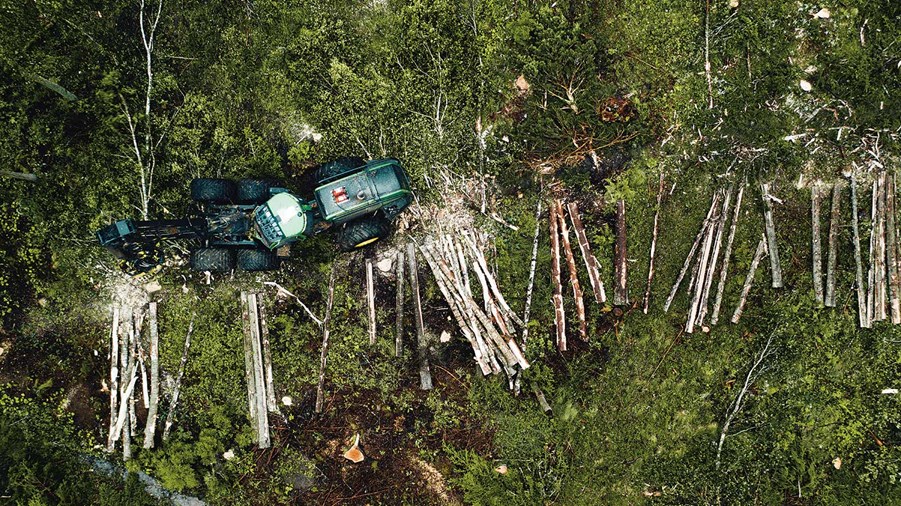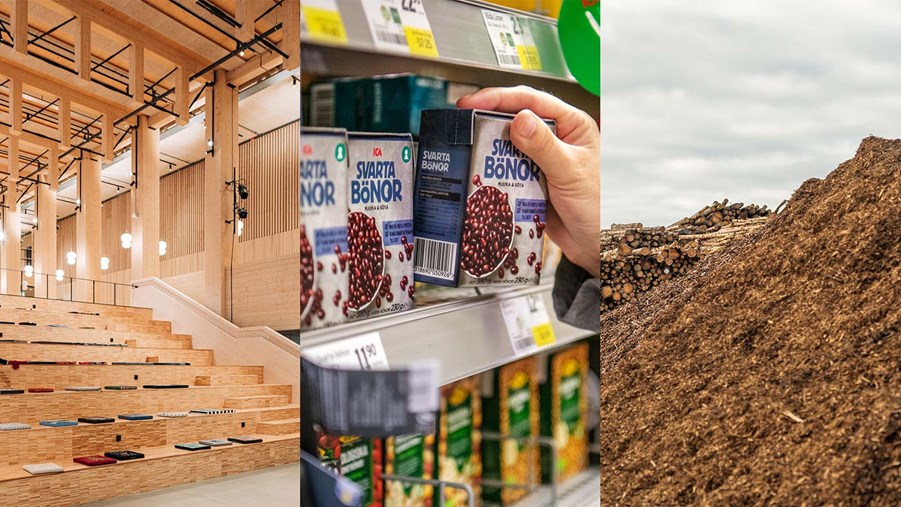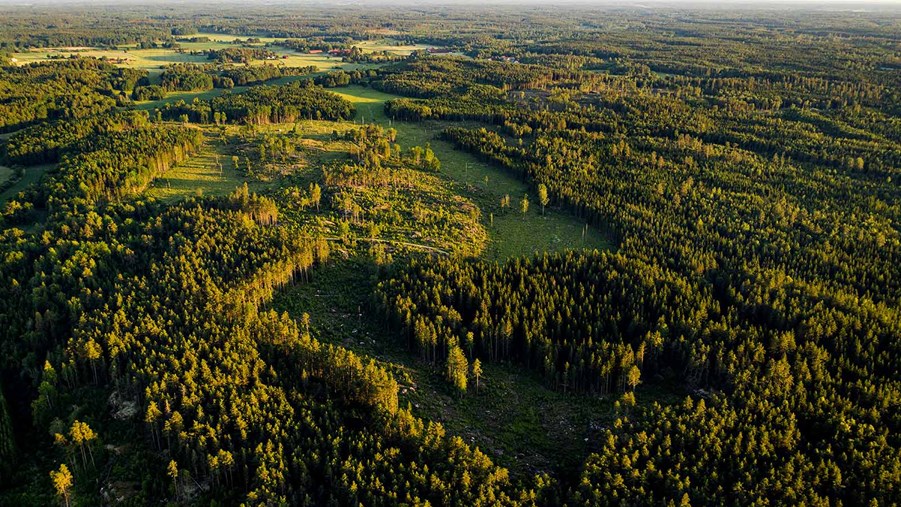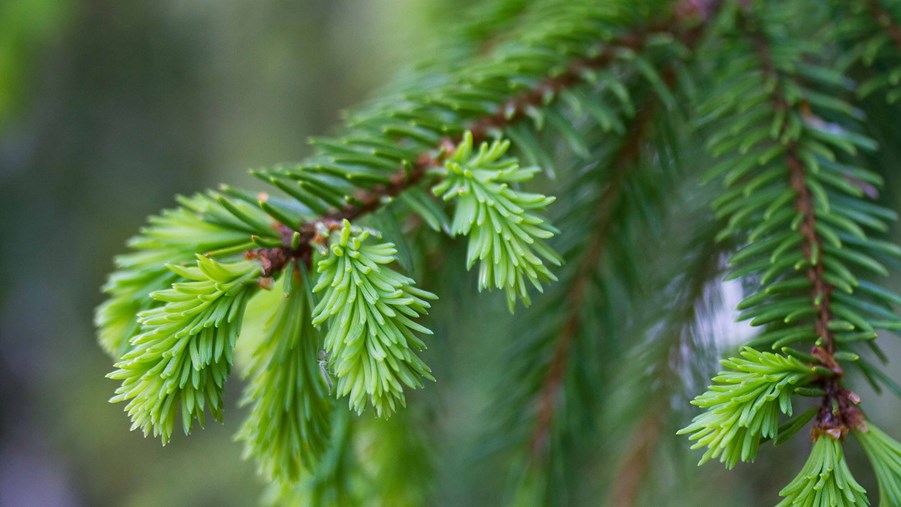
Some 75 per cent of the Swedish forest areais managed, typically to produce timber. Every year, 400 million saplings are planted in Sweden and approximately 1 per cent of the total forest area is harvested.
The Swedish Forest Act of 1903 was the first in the world to require reforestation. Today, this involves planting two to three new saplings for every tree that is felled. Forest owners are free to manage their forests according to their own objectives, but in combination with the responsibility to ensure that there is sufficient new forest and to preserve and develop environmental values. Under current Swedish forestry law, production and environmental aims take equal precedence. This means that it is just as important that forests’ environmental values are preserved and developed, as it is that forests providea high and value-adding wood production.
Aside the Swedish Forest Act, rules in the Environmental Protection Act also govern the way forestry can be conducted.
Sustainable forest management
The UN Food and Agricultural Organization and Forest Europe define sustainable forest management as “the stewardship and use of forests and forest lands in a way, and at a rate, which maintains their biodiversity, productivity, regeneration capacity, vitality and their potential to fulfil, now and in the future, relevant ecological, economic and social functions, at local, national and global levels, and that does not cause damage to other ecosystems.”
This definition is based on the aims of Agenda 2030, which is also the basis for forestry for a sustainable development in Sweden.
Even-aged retention forestry
Many Swedish tree species’ growth patterns are historically adapted to severe impacts caused by recurring storms and fire. Even-aged retention forestry with clear-cuts mimics these sorts of impacts and is the most common form of forest management conducted in Sweden.
The idea is to establish an even growth of forests of all ages across the entire forest landscape. This means felling trees in one area at a time and planting new seedlings after felling, ensuring that there are always growing forests of different ages across larger forest landscapes.
Uneven-aged forestry
Even-aged forestry is not the only way to manage forests. Interest in what is known as uneven-aged forestry, for example dimension cutting and selective felling, is increasing. In such cases, felling is often focused on trees of a certain size, for example.
Uneven-aged forestry can be a good alternative if special objectives need to be met that cannot be addressed with even-aged forestry. This could relate to improving recreational values in forests close to urban areas, for example, or preserving and promoting lichen-rich forests that are important for reindeer husbandry or to benefit certain species of fungi.
Forests and forestry in Europe
The forests in Europe differs depending on landscape, weather, climate, regulation and much more. The report Same but different – European forests and forestry illustrates the complexity of applying a uniform set of policies across such a varied continent as Europe. Read the report Same but different here.
Frequently asked questions about Swedish forestry and clearfelling
-
Sweden has a total land area of 40.7 million hectares. Seventy per cent of this is forest land, of which around 75 per cent is under long-term management. The forest is therefore one of Sweden’s most important renewable raw materials. It takes 60–120 years for a tree to grow large enough to be harvested. On average, 11 per cent of felled areas are left standing as basic retention.
Twenty-five per cent of Swedish forest land is excluded from forestry for various reasons. This can be due to environmental considerations or because the land is unproductive. Nine per cent of Swedish forest land is formally protected in nature reserves and other areas.
-
Swedish forests are well suited for clearfelling. Many Swedish tree species are adapted for major disturbances associated with frequent storms and fires. Clearfelling reproduces this type of disturbance and allows the forest to grow better, producing more wood that we can use for renewable products and benefitting the national economy.
Clearfelling is a major reason why the Swedish forest’s timber volume has more than doubled over the past 100 years. The method is designed to produce an even growth of differently aged forests across the forest landscape. Forests are harvested in one place at a time, but there are always plenty of growing forests of different ages distributed across larger landscape areas.
Another positive outcome of clearfelling, from an environmental perspective as well as for forestry economics, is that it enables the extraction of branches and tops for bioenergy production.
-
Clearfelling was introduced to Sweden in the early 1800s, but had its major breakthrough in the 1950s. The method is under constant development and refinement.
With the change in forest policy in the early 1990s, focus shifted to the environment and biodiversity. Today, clearfelling combines economically rational timber production with the conservation and development of biodiversity and other natural values. As an example, cleared areas today are smaller than they were in the 1950s. Rules have also been added regulating how consideration is to be taken of the environment and cultural heritage remains.
-
With the clearfelling method, forest management follows a cyclical process with various phases, just like in agriculture. The cycle starts with the forest owner planting, and then cleaning and thinning. During this time the forest is also monitored to detect and prevent threats such as pests, storms and fires. When it’s time to harvest, most of the trees in the stand are felled at the same time. Some trees and groups of trees – normally around 5–10 per cent of the area – are retained to preserve habitats for plants and animals and to mitigate the area’s bare appearance. After felling, new trees are planted and the cycle continues.
-
The average size of contiguous felled areas is 4.5 hectares and the median size is 2.5 hectares.
The median size of a felled area is 4.3 hectares in northern Norrland and 1.9 hectares in Götaland. The farther south you go, the smaller the felled areas.
Source: The Swedish Forest Agency
-
A cleared area might look messy, but there are good reasons for this. High stumps, for example, are a method of increasing the amount of deadwood in the forest, which is important for many insects. Trees are left standing in edge zones abutting lakes and watercourses and for nature conservation purposes. Individual splendid and impressive trees and groups of trees, and sometimes seed trees used for regeneration, can also be left standing. This is a common approach in certified forests – at least ten extra trees per hectare are left in the felled area, and there are regulations as to how much area can be cleared. Trees and deadwood are left lying on the ground to slowly decompose and provide a home for insects, lichen, moss, fungi, etc.
Read more about the Swedish forest industry’s outlook on and work with biodiversity.
-
The effect on the climate is the same whether you harvest trees that are scattered throughout the forest or those that are together in one place. All types of harvesting have the same effect on carbon dioxide absorption.
Growing trees absorb carbon dioxide through photosynthesis. In the growing forest, trees and other plants absorb more carbon dioxide than they emit and more than what is released when plant parts decompose and fall to the ground. Trees stop absorbing carbon dioxide when they are harvested – but emissions from ground vegetation and the decomposition of plants and plant parts continues. From the climate perspective, this worsens the carbon balance for some years. The same thing happens regardless of whether clearfelling or continuous cover methods are used.
There are no empirically based studies from Swedish forests showing that the carbon balance of a forest landscape managed with continuous cover methods would be more beneficial for the climate than a forest managed with clearfelling methods. But we do know that clearfelling results in higher growth in the forest, and therefore in a better carbon balance as compared with continuous cover methods.
-
Carbon dioxide is always leaking in the forest through the decomposition of dead trees, tree parts and other plants. After harvesting in a clear-felled area, photosynthesis basically stops because so many of the trees are gone, while the decomposition of the remaining tree parts continues. As a result, the outflow of carbon dioxide will be greater than the uptake for a number of years – in that particular area. But the carbon balance in forests needs to be viewed from a landscape perspective. By maintaining high growth throughout the entire forest landscape and not harvesting more than what grows, the surrounding growing forests compensate for the carbon loss that occurs in the harvested area. Within ten years, the carbon balance in the new forest is restored (Swedish University of Agricultural Sciences). The new forest growing in that particular area is serving once again as a carbon sink. The Swedish forest grows an average of 120 million cubic metres every year, corresponding to over 140 million tonnes of carbon sequestration per year.
Read more about carbon sinks, carbon sequestration and much more.
-
In both Sweden and the EU, we are facing important political decisions that affect forestry. This involves a wide range of interests—many more than those of the forest industry and forest owners. We see this in the intensified debate on the part of environmental organisations and others, and in the broad media coverage. The debate is also about the role of forests for the climate, and forests as an environment for recreation and experiences.
It is important to examine what is said by all stakeholders and the sources they rely on, and that different views are given equal space in the debate. There are differing opinions about how the forest can be most beneficial on various levels.


